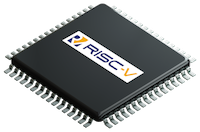
The Issue
Cyber-physical systems are becoming smaller, more versatile and more powerful. This opens a wide range of application areas, from smart homes and communication systems to transportation and logistics, industrial production and manufacturing. This versatility requires an adaptable and flexible architecture, as different application areas bring different requirements.
Today, the architecture of processors available on the market is dominated by a few manufacturers. The systems offered are proprietary, closed and often protected by patents. This limitation of the available hardware makes it difficult to develop new processors and on-chip systems based on them, which in turn makes innovation and new applications more difficult. How can this hurdle be overcome?
A Promising Approach: RISC-V

Open-source software makes its source code - which can be compared to the blueprint of a house - freely available. One widely used open-source system is Linux, which forms the core of the Android cell phone operating system. Inspired by the success of open-source software, open designs for hardware have also emerged recently. Among them is the RISC-V architecture, which is gaining enormous popularity.
RISC-V is an instruction set architecture: it defines the instructions with which a microprocessor can be programmed and how the microprocessor presents itself to the software, e.g., in terms of the registers offered and the possibilities for using them. This has the advantage that different software vendors can develop programs that run on the RISC-V architecture, and that different vendors can offer hardware implementations (processors) for this architecture. The open, standardized and patent-free architecture provides an important foundation for the development of a broad, rich ecosystem of hardware and software. RISC-V has been under development at the University of California, Berkeley, since 2010.
Main Advantages of RISC-V
RISC-V is scalable and can be adapted to the respective requirements with different word widths.
RISC-V is modular and can be flexibly extended.
RISC-V is future-proof because the system is standardized, vendor-independent and open.
Contributions of CPS
The DFKI Research Department Cyber-Physical Systems (CPS) contributes to the success of RISC-V in the following projects:
A Safe and Secure Sensor Platform for the Internet of Things, May 2023 - April 2026
An Extensible and Consistent Cross-Level RISC-V Verification Platform, August 2022 - July 2025
Hardening the Supply Chain through Open Source, Trustworthy EDA Tools and Processors, March 2021 - Febuary 2024
A consistent verification platform for early software development for RISC-V based systems, Aug 2019 - Jul 2022
Contact
Assistant to the management:
Kristiane Schmitt, M.A.
Kristiane.Schmitt@dfki.de
Phone: +49 421 218 59840
Deutsches Forschungszentrum für Künstliche Intelligenz GmbH (DFKI)
Cyber-Physical Systems
MZH
Bibliothekstr. 5
28359 Bremen
Germany
Cartesium
Enrique-Schmidt-Str. 5
28359 Bremen
Germany